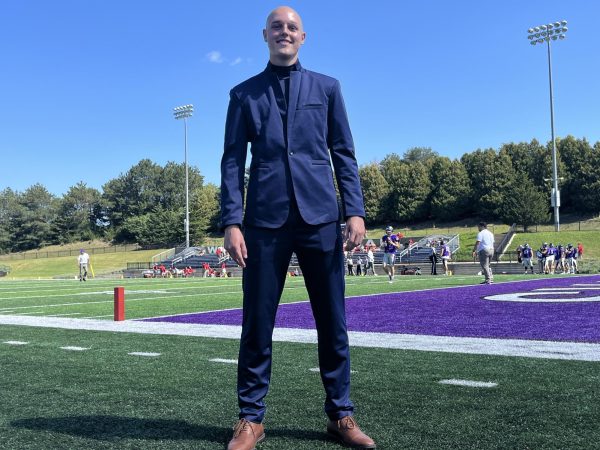Stories of Whitewater affected by history
March 5, 2023
From prehistoric people to modern college students, humans have had varying effects on Whitewater’s history and their stories tell us how we developed into present-day Whitewater.
For over 10,000 years, ancient peoples dwelt in the Whitewater area, but much of the cultural heritage they left behind has been removed from its original setting with the exception of the Effigy Mounds Preserve on the western edge of the city. This group of oval, conical, and animal effigy mounds was built by the Late Woodland People who occupied this region between 400 and 1100 A.D. The importance of the mounds to the Late Woodland culture is unknown, but they show that human stories go well beyond written history.
When the first European-American settlers came to Whitewater, they found remnants of another group of Native Americans, the Pottawatomi. The Pottawatomi migrated to the area from the eastern United States in the mid-1500s, but after 300 years, the Federal Government moved them out of the area in favor of white settlers. The story of the displacement of the Pottawatomi in 1833 brought about the era of the dominance of European-Americans in Whitewater.
White settlers came to Whitewater permanently in 1837 and were primarily from upper New York State and New England. Called “Yankees” by historians, these settlers established American institutions such as government, schools, churches, and social groups. The Yankee settlers put an “American” identity on Whitewater, an identity that is still prevalent today.
The story of industry dominated the economy of Whitewater during the 19th century. Building a grist mill in 1839 to grind the wheat grown by area farmers was one of the most important events in the community. Wheat harvesting also led to George Esterly’s invention of an improved wheat harvester in 1844. In 1857, Esterly started a factory in Whitewater to build wheat harvesters and other agricultural machinery. Between 1860 and 1895, the Esterly factory, along with the Winchester and Partridge Manufacturing Company, a plow and wagon factory, made Whitewater an “industrial” town.
During the industrial era, an important event would occur that would have a lasting impact on Whitewater, particularly during the 20th century. That event was the founding of the Whitewater Normal School (now UWW). In 1868, the state-chartered teacher’s college in Whitewater opened. Its growth and development stories would change Whitewater over many decades.
The late 19th and early 20th centuries is known as the “progressive era” when there was an expansion of government services and social institutions. In 1884, a public high school program was started in Whitewater and in 1889, the city contracted for a water system, one of the earliest communities to do so in the area. The pump house along Starin Road and the stone water tower in Starin Park are important artifacts that tell the story of this event.
Women’s rights and influence grew during the progressive era, even though they had no political power. A women’s suffrage organization was formed in Whitewater, but it was the Whitewater.
Federation of Women’s Clubs, formed in 1899, that helped women have an impact on the city’s civic life. The Federation raised money and lobbied for a public library building and it was a woman, Mary Flavia White, who funded it (now the Arts Alliance on Main Street) in 1903. The Federation lobbied for city improvements, sanitary conditions, and held health clinics. They provided women a large, collective, voice in changing the community. The Bassett House on Main Street is the historic home of the Federation that still operates in Whitewater today.
Other “progressive” events in Whitewater included the construction of the new Whitewater Depot in 1892, the transportation hub in the city; the establishment of electric power in 1886, and the building of a dozen new brick blocks in Whitewater’s downtown during the 1880s and 1890s. Perhaps the peak of this era was 1899-1900 when a large and impressive city hall was constructed on the corner of Whitewater and Center Streets. The old city hall, with a modern police and fire department, was a showpiece of the growth and importance of city government on the eve of the 20th century.
Both of Whitewater’s larger industries closed by 1895 and during the first half of the 20th century, the community’s economy relied on commercial businesses to survive. By 1900, most farmers were dairying, and dairy-related businesses in Whitewater fueled a slow, but steady economy. The biggest event in the growth of the dairy industry in Whitewater was the establishment of a large milk processing plant in 1913, a plant that lasted into the 1990s.
The event that dominated Whitewater during the mid to late 20th century and continues to dominate today is the growth and development of the old Normal School. In the mid-20th century, the Normal School expanded into a state college then a state university. Merging with the University of Wisconsin system in 1972, the old normal school became the University of Wisconsin-Whitewater. The growth and development of the UW-Whitewater is an ongoing “event” that has a continuing and significant impact on Whitewater.
Related to the story of the growth of the UWW was the most significant event of the late 20th century in Whitewater, the burning of Old Main in February of 1970. Not only did this event create a lasting emotional effect on townspeople, university students, and alumni, it physically changed the face of the campus. Many people still mourn the loss of Old Main and, perhaps, the “culture” of the university from that time period.
Whitewater’s stories continue to grow and change. A large university, a changing economy, and the diversification of the city’s population result in historical “events,” large and small, that continue to tell the stories of Whitewater.






















